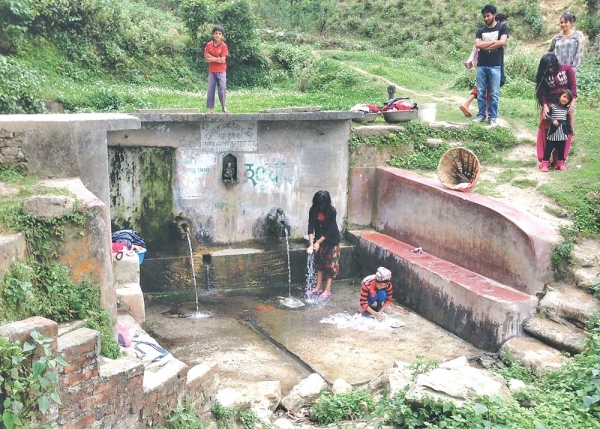Addressing water scarcity

In the middle hills of Nepal, securing water for drinking and livelihood-related activities is a big challenge. Despite the fact that Nepal’s annual per capita water availability is more than 8,000 cubic metres, this number does not mean much to the people living in the middle hills. There, rivers often lie at the bottom of steep mountain slopes, and must be pumped uphill. Pumping water is expensive, and not everyone can afford it. Communities have responded to these challenges in the past by collecting locally available spring water. But in recent years, these local springs have been drying up.
Causes and consequences
A study conducted in Kavre District by scientists at the Nepal Water Conservation Foundation (NWCF) and the International Centre for Integrated Mountain Development (ICIMOD) found that while the middle hills are richly endowed with local springs, as many as 30 percent have dried up in the last decade due to biophysical, technical, and socioeconomic factors. In addition, because of the earthquake in April 2015, most springs in the area yielded less water during the past winter season than in previous years and some have completely dried up. Although springs are the main water resource in the area, they have been all but neglected in local development plans. The implications of this are far-reaching—drying springs reduce agricultural harvests and force outmigration from the villages.
Our study of these issues over the past two years suggests that a stronger focus on water management at the local catchment level can play an important role in increasing water availability and improving community relations in areas that depend heavily on water. Research has found that good watershed management practices in upstream village development committees (VDCs) can bring opportunities to downstream VDCs in the form of sustained spring flow, whereas poor watershed management practices have the potential to increase the likelihood of landslides and contribute to low water flow in the dry season for downstream communities. In this way, downstream villages have both opportunities and potential threats linked to the management of water in upstream areas. Thus, these two parts of a river should be looked at together.
An example
In Sindhuli District, where downstream communities rely on water sources from upstream VDCs for drinking water and irrigation, the need for this upstream-downstream perspective is clear. Since 2014, ICIMOD has been working with HELVETAS Swiss Intercooperation and community members in the district to create master plans for two upstream VDCs—Jalkanya and Ratanchura—and two downstream VDCs—Bhimeshwor and Baseshwor. These plans include an inventory of local water sources and socioeconomic information from the four VDCs. They also outline water management strategies to meet domestic and agricultural needs. Until now, however, there has been no mechanism to bring these communities together in a formal way. After speaking with villagers in the upstream and downstream areas, both saw potential benefits in integrated management and were interested in future collaboration.
To make catchment-level management a reality, a system of cost and benefit sharing must be developed as a way to incentivise upstream and downstream communities to work together. Before this, however, efforts should be focused on further sensitising local communities on the need for an integrated management approach, setting up an informal mechanism that brings upstream and downstream communities together. Also, a detailed inventory of local water sources is necessary, and a government agency that would supervise this planning needs to be identified.
Our experience in both Sindhuli and Kavre suggests that catchment level planning can be initiated to address current water management challenges in the villages of the middle hills. This bottom-up approach is in line with the integrated water resources management approach envisaged in the National Water Plan of 2005, and provides a blueprint that can be used in other river basins in the region in the years to come.
Nepal is a Water and Climate Specialist; Neupane is a Socioeconomic Analyst at the International Centre for Integrated Mountain Development (ICIMOD)

Facebook comments